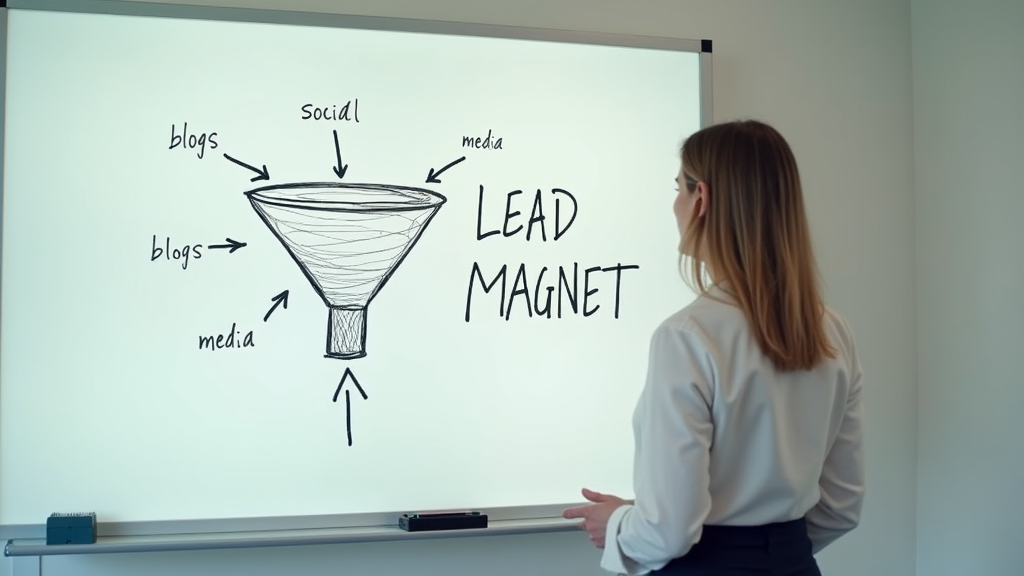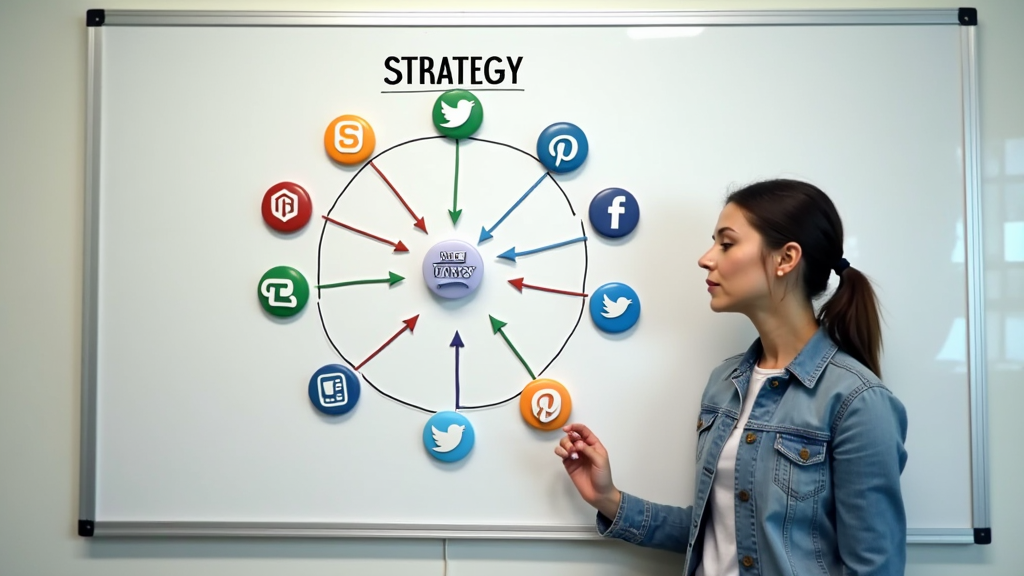
Lead generation is the lifeblood of any successful business. It's the process of attracting potential customers and converting them into people who are interested in your product or service. In today's competitive market, understanding and implementing effective lead generation strategies can make the difference between a thriving business and one that struggles to stay afloat.
Understanding Lead Generation
What Is Lead Generation?
Lead generation is the process of identifying and cultivating potential customers for your business's products or services. It's about finding people who might be interested in what you offer and guiding them towards making a purchase. This process is crucial for business growth because it helps you build a pipeline of potential customers, which can lead to increased sales and revenue.
The impact of lead generation on business growth can't be overstated. By consistently bringing in new leads, businesses can expand their customer base, increase brand awareness, and ultimately boost their bottom line. It's not just about making immediate sales; it's about creating a sustainable flow of interested prospects that can support long-term business success.
Types of Leads
Not all leads are created equal. Understanding the different types of leads can help you tailor your approach and improve your conversion rates. Here are the main types of leads you'll encounter:
-
Marketing Qualified Leads (MQLs): These are leads who have shown interest in your marketing efforts but aren't quite ready to make a purchase. They might have downloaded a whitepaper or signed up for your newsletter.
-
Sales Qualified Leads (SQLs): These leads have moved beyond initial interest and are considered ready for direct sales contact. They might have requested a demo or pricing information.
-
Product Qualified Leads (PQLs): These are leads who have used your product (often through a free trial or freemium model) and taken actions that indicate they're likely to become a paying customer.
Understanding these lead types helps you create more targeted marketing and sales strategies, ensuring you're not wasting resources on leads that aren't ready to convert.
The Lead Generation Process
The lead generation process typically involves several steps:
-
Attracting prospects: This is about getting your brand in front of potential customers through various marketing channels.
-
Capturing information: Once you've attracted attention, you need to gather contact details and other relevant information from your prospects.
-
Nurturing leads: Not all leads are ready to buy immediately. Nurturing involves building relationships with leads over time, providing value, and keeping your brand top-of-mind.
-
Converting leads to customers: The final step is turning those nurtured leads into paying customers through targeted sales efforts.
Each of these steps requires careful planning and execution to maximize your lead generation efforts.
Essential Lead Generation Strategies
Content Marketing
Content marketing is a powerful tool for lead generation. By creating valuable, relevant content, you can attract potential customers and establish your brand as a trusted authority in your industry.
Blogging is often the cornerstone of content marketing. Regular blog posts can help improve your search engine rankings, provide value to your audience, and give you content to share on social media. For example, a software company might write blog posts about industry trends, how-to guides, or case studies of successful customers.
Whitepapers and ebooks are longer-form content that can be particularly effective for lead generation. These in-depth resources often require users to provide their contact information to download, making them excellent lead capture tools. For instance, a marketing agency might offer an ebook on "10 Proven Strategies to Boost Your Social Media Engagement" in exchange for an email address.
Infographics and videos can help make complex information more digestible and shareable. They're particularly effective for reaching audiences who prefer visual content. A financial services company, for example, might create an infographic explaining different investment strategies or a video series on personal finance tips.
Search Engine Optimization (SEO)
SEO is critical for making sure your content reaches your target audience. It involves optimizing your website and content to rank higher in search engine results for relevant keywords.
Keyword research is the foundation of effective SEO. Tools like Google Keyword Planner or SEMrush can help you identify the terms your potential customers are searching for. Once you've identified these keywords, you can incorporate them into your website content, blog posts, and meta descriptions.
On-page SEO involves optimizing individual web pages to rank higher and earn more relevant traffic. This includes optimizing your title tags, headers, and content for your target keywords. Off-page SEO, on the other hand, refers to actions taken outside of your website to improve its search rankings, such as building high-quality backlinks.
For businesses with physical locations, local SEO is particularly important. This involves optimizing your online presence to attract more business from relevant local searches. Claiming your Google My Business listing, getting listed in local directories, and encouraging customer reviews can all help improve your local SEO.
Social Media Marketing
Social media platforms offer powerful tools for lead generation. The key is to choose the right platforms based on where your target audience spends their time online.
An organic content strategy involves regularly posting engaging content that provides value to your followers. This could include industry news, tips and advice, behind-the-scenes glimpses of your company, or user-generated content. The goal is to build relationships and trust with your audience, which can lead to more qualified leads over time.
Paid social media advertising allows you to reach a wider audience beyond your current followers. Platforms like Facebook and LinkedIn offer sophisticated targeting options, allowing you to reach potential customers based on demographics, interests, behaviors, and more.

Email Marketing
Email marketing remains one of the most effective lead generation strategies. It allows you to communicate directly with potential customers who have already shown interest in your brand.
Building and segmenting your email list is crucial for effective email marketing. You can build your list through lead magnets (like the whitepapers and ebooks mentioned earlier), newsletter sign-ups, and other opt-in methods. Segmenting your list based on factors like demographics, past purchases, or engagement level allows you to send more targeted, relevant emails.
Crafting compelling email campaigns is an art and a science. Your emails should provide value to the recipient, whether that's through exclusive content, special offers, or helpful information. The subject line is particularly important – it needs to be engaging enough to entice the recipient to open the email.
Automation can significantly enhance your email marketing efforts. Drip campaigns, for example, allow you to send a series of pre-written emails to leads over time, nurturing them towards a purchase decision. Tools like Mailchimp or HubSpot can help you set up and manage these automated campaigns.
Advanced Lead Generation Techniques
Account-Based Marketing (ABM)
Account-Based Marketing is a highly targeted approach to B2B marketing. Instead of casting a wide net, ABM focuses on a small number of high-value accounts.
The first step in ABM is identifying your ideal target accounts. These are typically companies that are most likely to become valuable, long-term customers. Once you've identified these accounts, you can create highly personalized content and outreach strategies for each one.
A multi-channel approach is key to successful ABM. This might involve personalized emails, targeted ads on social media and other platforms, custom landing pages, and even direct mail. The goal is to surround your target accounts with consistent, personalized messaging across multiple touchpoints.
Influencer Partnerships
Partnering with influencers can be an effective way to reach new audiences and generate leads. The key is finding influencers whose followers align with your target audience.
When looking for relevant influencers, consider both reach (how many followers they have) and engagement (how much their followers interact with their content). Micro-influencers, who have smaller but highly engaged followings, can often provide better ROI than celebrities with millions of followers.
Collaboration strategies might include sponsored posts, product reviews, or co-created content. For example, a fitness equipment company might partner with fitness influencers to demonstrate their products in workout videos.
Measuring the success of influencer campaigns is crucial. This might involve tracking unique discount codes, custom landing pages, or using UTM parameters to track traffic from influencer posts.
Webinars and Virtual Events
Webinars and virtual events can be powerful lead generation tools, especially for B2B companies. They allow you to showcase your expertise, provide value to attendees, and capture leads in a highly engaged setting.
Planning and promoting your webinar is crucial for its success. Choose a topic that's relevant and valuable to your target audience. Promote the webinar through your email list, social media channels, and potentially through paid advertising.
Creating engaging content for your webinar is key. This might include a mix of presentation, demonstration, and Q&A sessions. Interactive elements like polls or breakout rooms can help keep attendees engaged.
Follow-up is critical for converting webinar attendees into leads. Send a thank-you email with a recording of the webinar, additional resources, and a clear call-to-action for next steps.
Lead Generation Tools and Technologies
Customer Relationship Management (CRM) Systems
A good CRM system is essential for managing and nurturing leads effectively. Popular options include Salesforce, HubSpot CRM, and Pipedrive.
Key features to look for in a CRM for lead generation include:
- Contact management
- Lead scoring
- Email integration
- Task management
- Reporting and analytics
Marketing Automation Platforms
Marketing automation platforms can significantly streamline your lead generation efforts. These tools allow you to automate repetitive tasks, nurture leads, and deliver personalized content at scale.
Key automation capabilities to look for include:
- Email marketing automation
- Lead scoring and segmentation
- Social media scheduling
- Landing page and form builders
- Analytics and reporting
Popular marketing automation platforms include Marketo, Pardot, and ActiveCampaign.
Lead Scoring and Qualification Tools
Lead scoring helps you prioritize your leads based on their likelihood to convert. This allows your sales team to focus their efforts on the most promising leads.
Implementing a lead scoring model typically involves assigning points to leads based on various attributes and behaviors. For example, you might assign points for:
- Demographic information (job title, company size, industry)
- Engagement with your content (email opens, website visits, content downloads)
- Social media interactions
- Webinar attendance
AI-powered lead qualification tools can take this a step further by using machine learning algorithms to predict which leads are most likely to convert. Tools like Leadspace and Infer offer these advanced capabilities.
Optimizing Your Lead Generation Funnel
Creating Compelling Landing Pages
Landing pages are often the first point of contact between your business and potential leads. Creating high-converting landing pages is crucial for effective lead generation.
Essential elements of a high-converting landing page include:
- A clear, compelling headline
- Concise, benefit-focused copy
- A strong call-to-action (CTA)
- Social proof (testimonials, case studies, etc.)
- A simple, user-friendly design
A/B testing is crucial for optimizing your landing pages. This involves creating two versions of a page with a single element changed, then seeing which performs better. You might test different headlines, CTA buttons, images, or form lengths.
Implementing Effective Call-to-Actions (CTAs)
Your CTA is what prompts visitors to take the next step and become a lead. Effective CTAs can significantly boost your conversion rates.
CTA placement is crucial. Your CTA should be prominently displayed and easy to find. For longer pages, consider including multiple CTAs throughout the content.
Persuasive copywriting techniques can make your CTAs more effective. Use action-oriented language, create a sense of urgency, and clearly communicate the value proposition. For example, instead of "Submit," you might use "Get Your Free Guide Now."
Lead Magnet Development
Lead magnets are offers that provide value to your potential customers in exchange for their contact information. They're a key tool for capturing leads.
Different types of lead magnets work better for different audiences and stages of the buyer's journey. Some popular types include:
- Ebooks and whitepapers
- Free trials or demos
- Webinars or video series
- Templates or tools
- Quizzes or assessments
The key is to match your lead magnet to your buyer personas. For example, if you're targeting busy executives, a short, actionable checklist might be more effective than a lengthy ebook.
Retargeting and Remarketing Strategies
Retargeting allows you to show ads to people who have previously interacted with your website or content. This can be a highly effective way to re-engage potential leads who didn't convert on their first visit.
Implementing retargeting starts with placing a pixel on your website. This small piece of code allows you to track visitors and show them ads on other websites or social media platforms.
Creating effective retargeting campaigns involves segmenting your audience based on their behavior on your site. For example, you might show different ads to people who abandoned their cart versus those who just browsed your homepage.

For entrepreneurs and SaaS founders looking to capture leads efficiently, FastWaitlist offers customizable waitlist pages. This tool can be particularly useful for businesses launching new products or services.
Measuring and Analyzing Lead Generation Success
Key Performance Indicators (KPIs)
Tracking the right KPIs is crucial for understanding the success of your lead generation efforts. Some important metrics to monitor include:
- Lead volume: The total number of leads generated
- Lead quality: Often measured by lead-to-customer conversion rate
- Cost per lead (CPL): The average cost to acquire a new lead
- Conversion rate: The percentage of visitors who become leads
- Time to conversion: How long it takes for a lead to become a customer
Regularly analyzing these metrics can help you identify areas for improvement in your lead generation strategy.
Analytics Tools and Dashboards
Google Analytics is a powerful, free tool for tracking website traffic and user behavior. To use it effectively for lead tracking, you'll need to set up goal tracking for key conversion actions on your site.
Creating custom reports and dashboards can help you quickly visualize your most important lead generation metrics. Many CRM and marketing automation platforms offer built-in reporting features. For more advanced analytics, tools like Tableau or Power BI can help you create custom dashboards.
Continuous Improvement Process
Lead generation isn't a "set it and forget it" process. It requires ongoing optimization and improvement.
Regular performance reviews are crucial. Set aside time each month or quarter to review your lead generation metrics and identify areas for improvement.
A/B testing should be an ongoing part of your lead generation efforts. Continuously test different elements of your landing pages, emails, ads, and other lead generation assets to improve their performance.
Adapting your strategies based on data insights is key to long-term success. Be prepared to pivot your approach if the data shows that certain strategies aren't working as well as others.
For those using FastWaitlist, the platform offers built-in analytics to track and measure waitlist performance, allowing for data-driven optimization of your lead capture process.
Overcoming Common Lead Generation Challenges
Dealing with Low-Quality Leads
Not all leads are created equal, and dealing with a high volume of low-quality leads can waste time and resources. To address this:
- Refine your targeting: Ensure your marketing efforts are reaching the right audience.
- Improve lead scoring: Implement or refine your lead scoring system to better identify high-quality leads.
- Enhance lead nurturing: Develop more effective nurturing campaigns to qualify leads before passing them to sales.
Balancing Quantity and Quality
While it's tempting to focus solely on generating a high volume of leads, quality is equally important. Strive for a balance by:
- Setting both quantity and quality goals
- Focusing on channels that produce the highest quality leads
- Regularly reviewing and adjusting your lead generation strategies based on performance
Aligning Sales and Marketing Teams
Misalignment between sales and marketing can lead to ineffective lead generation and follow-up. To improve alignment:
- Establish clear definitions for qualified leads
- Create a formal process for lead handoff from marketing to sales
- Implement regular meetings between sales and marketing teams to discuss lead quality and strategies
By addressing these common challenges, you can create a more effective and efficient lead generation process that drives real business growth.
Lead generation is a complex and ongoing process, but mastering it can lead to significant business growth. By understanding the fundamentals, implementing effective strategies, leveraging the right tools, and continuously optimizing your approach, you can create a steady stream of high-quality leads for your business. Remember, the key to success is to stay adaptable, keep learning, and always put your potential customers' needs first.
